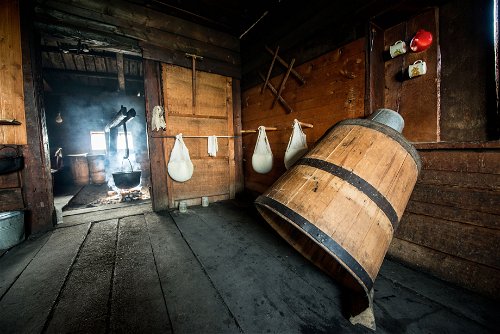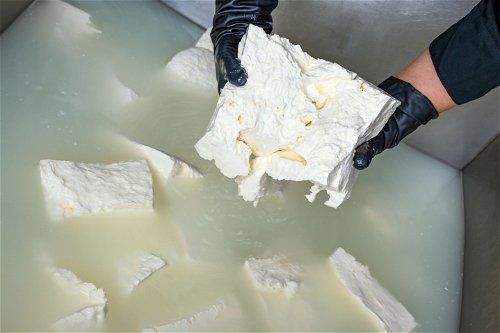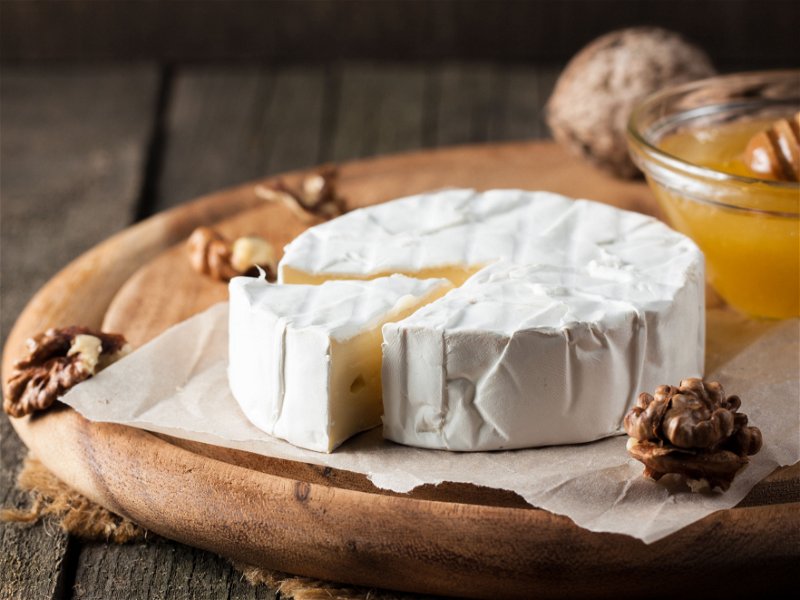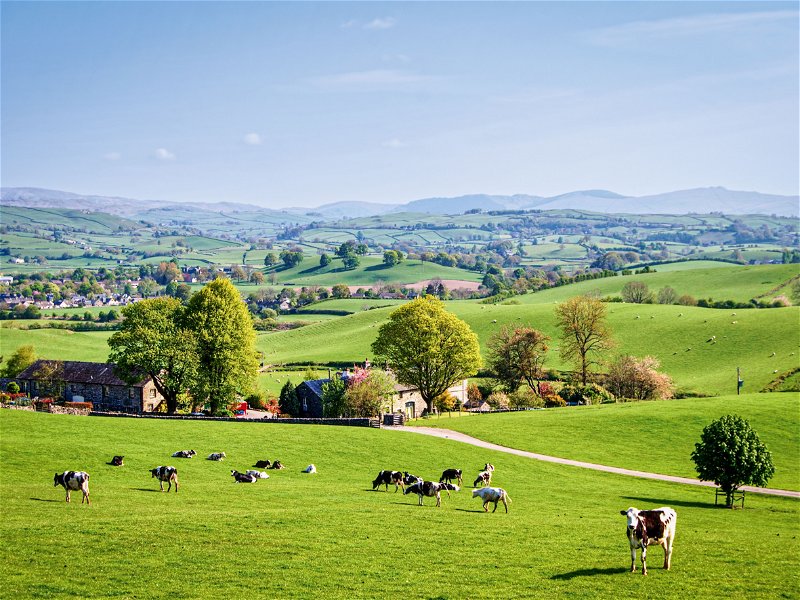White gold: cheese you should know – feta
Greece is one of the cradles of European civilization. It is therefore not surprising that cheese was made there thousands of years ago. Feta is an ancient cheese that is still the most popular type of Greek cheese in Greece and abroad.
If we are to believe the ancient Greek poet Homer, the Cyclopes once tried their hand at the art of cheese making: in the Odyssey - one of his greatest works - he describes in the 8th century BC how the mythical hero Odysseus observes that the one-eyed mythical creatures in their caves keep sheep and process their milk into cheese. What's more, Odysseus even steals a piece of this forerunner of today's feta during his escape. In fact, cheese appears frequently in Greek mythology. The god Aristaios is said to have learned how to make cheese from nymphs and then passed on his knowledge to humans. Whether invented by nymphs, gods, Cyclopes or humans, it is certain that the production of goat's and sheep's cheese is ancient in Greece. The country has a rich shepherding tradition; to this day, flocks of goats and sheep are led by their owners across the barren meadows on remote islands to find their food. In return, they provide milk, cheese and occasionally meat.
The first modern description of a cheese that appears to be identical to today's feta dates back to the 15th century. At that time, the Italian Pietro Casola described how a cheese stored in a wooden barrel was sold in slices - "fetta" in Italian - in the port of the Cretan city of Heraklion. This term then gave rise to the modern name feta. Until the 19th century, its common name was "prosfatos", which translates as "fresh" or "recent", an allusion to the fact that it is not stored for a long time, but eaten fresh. The Venetians conquered large parts of what is now Greece in the 13th century, and Crete was even under their rule until the 17th century. The local culture was significantly influenced by the occupying forces; among other things, the most famous of all Greek cheeses became feta. By the 19th century at the latest, the name had become naturalized throughout the country and replaced "Prosfatos".
Export hit feta
For a long time, feta was mainly known in Greece. It is still the most popular cheese there today, with around 85 percent of the production volume being consumed in the country itself. Its international fame began with the emigration of large parts of the Greek population: from the 19th century onwards, there were repeated waves of emigration due to economic crises, wars and poverty. The Greeks brought their favorite cheese with them, which was soon also in demand abroad. For a long time, importing foreign fresh produce was very complicated, which is why the Greeks abroad began to produce feta-like cheese themselves. Because there was not enough sheep's and goat's milk everywhere, they also used cow's milk.
From its origin; the cow's milk version tasted significantly milder and became more popular than the original, especially in countries without a sheep's cheese tradition. Over time, countries such as Germany, France and especially Denmark became major producers of these copies and even exported them as feta. This, in turn, was not acceptable to the Greeks. In order to restore their wounded national pride, they initiated a process to have feta protected throughout the EU with the designation of origin "PDO". This was recognized in 2002, and since then the cheese may no longer be produced under this name in the rest of Europe. These rules do not apply outside the EU, which is why you can still often find locally produced "feta" overseas.

According to the rule book, feta may only be cheesed on the Greek mainland and the island of Lesbos. It must consist of at least 70 percent sheep's milk from local breeds; only local goat's milk is permitted as an additive. Due to the great diversity of the animals, the herbs they eat and the climates in which they are kept, there are regional differences in feta. In general, feta from Macedonia and Thrace is quite soft and mild, with few holes. Cheese from Thessaly and central Greece, on the other hand, is harder and tastes more rustic, while that from the Peloponnese is somewhat drier and has a very intense flavor.
Cheese from the barrel
The production of feta is not particularly complicated. Milk is brought fresh to the cheese dairy, where it is usually pasteurized. Lactic acid bacteria cultures are added to the cheese to give it the sour taste typical of feta. When the pasteurized milk has cooled to 35 degrees, rennet is stirred in - in a few traditional farms it is still obtained from the stomachs of their own dairy lambs, but industrial vegetarian rennet is usually used. After just under half an hour, the milk has curdled into a gel-like mass.
It is cut with a cheese harp to separate the solid part of the cheese, the curd, from the liquid part, the whey. The curd is then scooped into rectangular, perforated or grooved molds for draining. Within a few hours, the young loaves become firm and can be removed from the mold, cut and rubbed with salt. In the next step, the rather large, rectangular cheeses are layered in metal containers or - the traditional method - wooden barrels. After a few days of dry maturing, the containers are filled with brine.
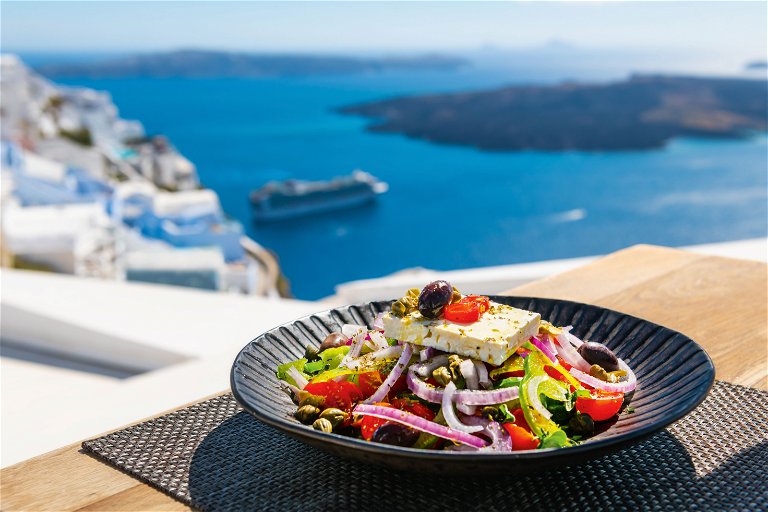
Then the actual maturing period begins, which lasts at least two months and consists of two phases: For the first 15 days, the containers remain in the maturing cellar at a temperature of 18 degrees, then they are placed in a room cooled to between two and four degrees - there is 85 percent humidity in both. Cheeses generally mature longer in wooden barrels, giving them more aromatic complexity. After a maximum of one year, the cheeses are delivered to retailers in barrels or metal containers or cut into slices and individually shrink-wrapped in plastic. Once the pack has been opened, the cheese will keep for five to seven days in an airtight container in the fridge, or even up to a month if it is put back in brine. Feta is not only an essential component of Greek salads; there are countless traditional recipes in which it is an important ingredient. The Greek Orthodox calendar contains over 180 days of fasting, so the Greeks became masters of meatless cuisine and cheese became an important source of protein. Feta is used as a filling in spinach pie spanakopita and cheesecake tiropita, in omelettes, as fried cheese and for stuffing vegetables, but it is also eaten simply with olive oil and bread.
Of course, it is also suitable for creative cuisine. On the social media app Tiktok, a recipe in which he plays the leading role has been shared millions of times: A pasta with a sauce made from feta, cherry tomatoes and garlic, which are baked and then crushed. When the recipe went viral in 2021, the US ordering company Instacart recorded a 112 percent increase in feta sales; in many supermarkets around the world, it was almost impossible to find. The Greek flagship cheese with a 3000-year history has therefore arrived safely in the present.

Related varieties
Feta-like cheese is also produced in Greece outside the areas protected by the designation of origin, sometimes in very high quality. This is called Lefko Tyri, white cheese. In Turkey and the Balkans, many similar cheeses are made from cow's, sheep's or goat's milk or a mixture of the two according to the same principle. They are also often called "white cheese" in the local language, for example Beyaz Peynir in Turkey, Bjalo Sirene in Bulgaria and Beli Sir in Slovenia.
There are also a number of related brine cheeses in the Arab world and the Caucasus, such as the Egyptian Domiati, the Palestinian Nabulsi and the Georgian Sulguni. The Spanish Queso de Burgos is similar, but is eaten very young. Emigrants from the Mediterranean region have made brine cheese popular overseas, especially in Latin America, where the Mexican cotija is made from cow's milk. In German-speaking Europe, cheeses based on feta continue to be produced; they are often called salad cheese or shepherd's cheese.
Lefko Tyri - white cheese
There is also brine cheese in regions of Greece where feta is not allowed to be produced. These are usually called Lefko Tyri.

Beyaz Peynir - Turkey
In Turkey, Beyaz Peynir brine cheese is made from sheep's milk, cow's milk, goat's milk or another mixture of these.

Bjalo Siren
White cheese is a staple food in Bulgaria. It is usually made from sheep's milk.



